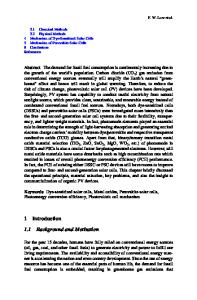Photon Management for Near-Total Solar Absorption in Hematite Photoanodes
- PDF / 17,241,952 Bytes
- 6 Pages / 612 x 792 pts (letter) Page_size
- 13 Downloads / 387 Views
Photon Management for Near-Total Solar Absorption in Hematite Photoanodes Ken Xingze Wang1, Zongfu Yu1, Victor Liu1, Mark L. Brongersma1, Thomas F. Jaramillo1, and Shanhui Fan1 1 Stanford University, Stanford, CA 94305, U.S.A. ABSTRACT Using first-principles full-field electromagnetic simulations, we demonstrate that nearperfect above-band-gap solar absorption can be achieved in nanostructured, ultra-thin-film iron oxide photoanodes for photoelectrochemical (PEC) water splitting. In our designed core-shell nanocone structures, all regions of hematite (α-iron oxide) are away from the interface between hematite and water by a minimum distance of less than the hole diffusion length in hematite, which is assumed to be no greater than 20nm. The optical absorption in our structure corresponds to a photocurrent density of 12.5mA/cm2 if one assumes an air mass 1.5 solar spectrum and a unity absorbed photon-to-current efficiency (APCE) for all wavelengths in that spectrum. Our photon management strategy eliminates the trade-off between optical absorption and carrier collection as commonly found in conventional designs of PEC cells, and variants of the strategy are generally applicable to other material systems. INTRODUCTION Hematite (α-iron oxide) is a promising material for the photoelectrochemical conversion of sunlight to fuel [1,2]. If every above-bandgap photon can contribute to water splitting, a hematite photoanode could generate a theoretical maximum current of 12.5mA/cm2 under the air mass 1.5 solar spectrum. However, in practice, hematite photoanodes produce photocurrents far lower than this theoretical maximum, due in large part to the extremely short diffusion length of charge carriers [2-4]. As a result, only sunlight absorbed within a very thin, nanoscale layer of hematite near the water interface can contribute. This severely limits the efficiency of PEC cells. A number of approaches have been carried out to maximize absorption in hematite, such as stacking multiple layers in tandem [5-7], porous thin films [8-10], nanostructured arrays [11-13], and plasmonics [14-16]. None of these approaches has yet to reach nearly complete absorption in a hematite photoanode.
Figure 1. The core-shell nanocone array. (a) A three-dimensional view of the right circular cones forming a square lattice on the substrate. (b) A vertical cross section through the apex showing the ITO core and the hematite shell.
In this work, we seek to overcome this difficulty by considering an appropriate optical design for a hematite photoanode as shown in Figure 1, which consists of a nanoscale hematite layer coated on a nanocone array made of a transparent conducting oxide. At the front face of the hematite layer is the water interface. Hematite has a hole diffusion length in the range of 2nm to 20nm [3,4]. In our calculation, we first assume a hole diffusion length of 20nm. In Figure 1, no regions of hematite are more than 20nm from the water-hematite interface, satisfying electronic considerations in terms of carrier diffusion. Using optic
Data Loading...










